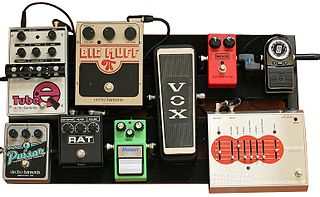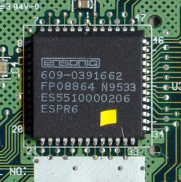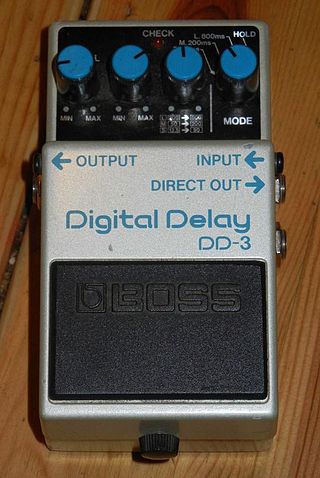
An effects unit, effects processor, or effects pedal is an electronic device that alters the sound of a musical instrument or other audio source through audio signal processing.

A sound effect is an artificially created or enhanced sound, or sound process used to emphasize artistic or other content of films, television shows, live performance, animation, video games, music, or other media.
Time stretching is the process of changing the speed or duration of an audio signal without affecting its pitch. Pitch scaling is the opposite: the process of changing the pitch without affecting the speed. Pitch shift is pitch scaling implemented in an effects unit and intended for live performance. Pitch control is a simpler process which affects pitch and speed simultaneously by slowing down or speeding up a recording.
Flanging is an audio effect produced by mixing two identical signals together, one signal delayed by a small and (usually) gradually changing period, usually smaller than 20 milliseconds. This produces a swept comb filter effect: peaks and notches are produced in the resulting frequency spectrum, related to each other in a linear harmonic series. Varying the time delay causes these to sweep up and down the frequency spectrum. A flanger is an effects unit that creates this effect.

Dynamic range compression (DRC) or simply compression is an audio signal processing operation that reduces the volume of loud sounds or amplifies quiet sounds, thus reducing or compressing an audio signal's dynamic range. Compression is commonly used in sound recording and reproduction, broadcasting, live sound reinforcement and some instrument amplifiers.
The Environmental Audio Extensions are a number of digital signal processing presets for audio, present in Creative Technology Sound Blaster sound cards starting with the Sound Blaster Live and the Creative NOMAD/Creative ZEN product lines. Due to the release of Windows Vista in 2007, which deprecated the DirectSound3D API that EAX was based on, Creative discouraged EAX implementation in favour of its OpenAL-based EFX equivalent – though at that point relatively few games used the API.

SoundStorm is a brand by Nvidia referring to a SIP block integrating 5.1 surround sound technology found on the die of their nForce and nForce2 chipsets for x86 CPUs. It is also the name of a certification to be obtained from Nvidia when complying with their specifications.
Line 6 is a musical instrument and audio equipment manufacturer, best known as a pioneer in guitar amplifier and effect modeling. The company's products include guitar effects, modeling guitar amplifiers, software, electric guitars, and wireless systems. Line 6 has an active user community, and provides software that allows users to easily download and share patches or device settings for many of the company's products. Founded in 1996 and headquartered in Calabasas, California, the company has been a subsidiary of Yamaha Corporation since 2014.
A phaser is an electronic sound processor used to filter a signal by creating a series of peaks and troughs in the frequency spectrum. The position of the peaks and troughs of the waveform being affected is typically modulated by an internal low-frequency oscillator so that they vary over time, creating a sweeping effect.
Chorus is an audio effect that occurs when individual sounds with approximately the same time, and very similar pitches, converge. While similar sounds coming from multiple sources can occur naturally, as in the case of a choir or string orchestra, it can also be simulated using an electronic effects unit or signal processing device.

Pitch correction is an electronic effects unit or audio software that changes the intonation of an audio signal so that all pitches will be notes from the equally tempered system. Pitch correction devices do this without affecting other aspects of its sound. Pitch correction first detects the pitch of an audio signal, then calculates the desired change and modifies the audio signal accordingly. The widest use of pitch corrector devices is in Western popular music on vocal lines.

Pitch shifting is a sound recording technique in which the original pitch of a sound is raised or lowered. Effects units that raise or lower pitch by a pre-designated musical interval (transposition) are known as pitch shifters.

The Ensoniq ESP was used in many of the company's musical instruments and on their Soundscape Elite PC ISA sound card. It was used to enhance the synthesizer's audio samples with digital effects, enhancing the realism of the overall sound.

Delay is an audio signal processing technique that records an input signal to a storage medium and then plays it back after a period of time. When the delayed playback is mixed with the live audio, it creates an echo-like effect, whereby the original audio is heard followed by the delayed audio. The delayed signal may be played back multiple times, or fed back into the recording, to create the sound of a repeating, decaying echo.

TC Electronic is a Danish audio equipment company that designs and imports guitar effects, bass amplification, computer audio interfaces, audio plug-in software, live sound equalisers, studio and post-production equipment, studio effect processors, and broadcast loudness processors and meters. In August 2015, the company was purchased by Music Group, a holding company chaired by Uli Behringer.
A digital delay line is a discrete element in a digital filter, which allows a signal to be delayed by a number of samples. Delay lines are commonly used to delay audio signals feeding loudspeakers to compensate for the speed of sound in air, and to align video signals with accompanying audio, called audio-to-video synchronization. Delay lines may compensate for electronic processing latency so that multiple signals leave a device simultaneously despite having different pathways.
Musical outboard equipment or outboard gear is used to process or alter a sound signal separately from functionality provided within a mixing console or a digital audio workstation. Outboard effects units can be used either during a live performance or in the recording studio.

Record is a music software program developed by Swedish software developers Propellerhead Software. Designed for recording, arrangement and mixing, it emulates a recording studio, with a mixing desk, a rack of virtual instruments and effects and an audio and MIDI sequencer. Record can be used either as a complete virtual recording studio in itself, or together with Propellerhead Software's Reason.
Source Audio is a guitar effects pedal company based near Boston, Massachusetts. They produce modular effects pedals for electric guitar and bass, such as the Nemesis Delay, Ventris Dual Reverb, and Collider Delay+Reverb, as well as the C4 Synth, a modular rack synthesizer in pedal format, the Aftershock Bass Distortion, and the EQ2, a 10-band parametric equalizer with a plug-in style desktop interface. They are also the creators of the Hot Hand Wireless Effects Controller, a device worn around the finger that uses an accelerometer to send expression signal to an effect like an envelope filter. Source Audio mainly uses DSP to create their effects, and are known to program their own processor chips.
ValhallaDSP is a company and brand name for multiple digital reverberator and delay plugins for Macintosh and Windows computers made by Sean Costello.

















